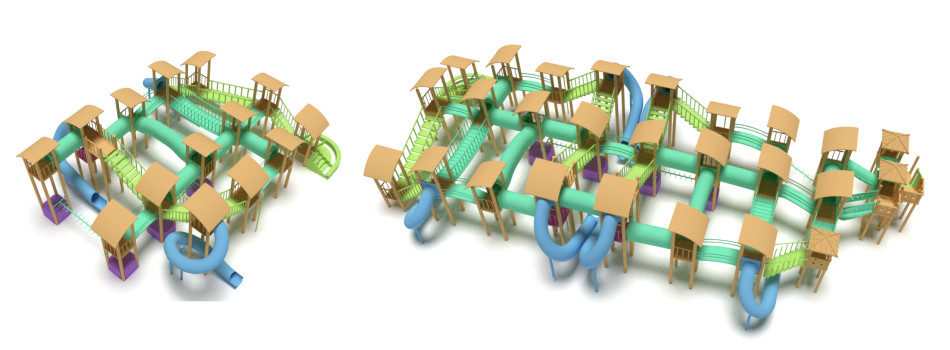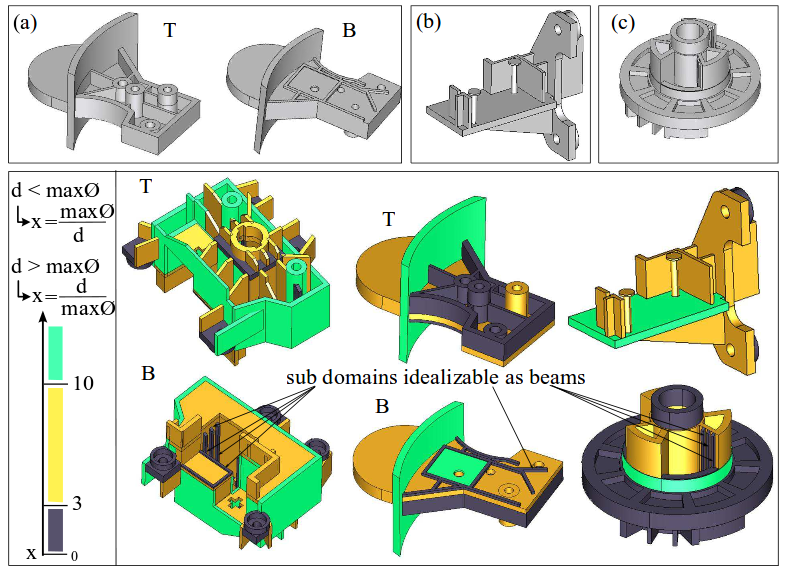Section: New Results
User-centered Models for Shapes and Shape Assemblies
Our goal, is to develop responsive shape models, i.e. 3D models that respond in the expected way under any user action, by maintaining specific application-dependent constraints (such as a volumetric objects keeping their volume when bent, or cloth-like surfaces remaining developable during deformation, etc). We are extending this approach to composite objects made of distributions and/or combination of sub-shapes of various dimensions.
Developable Surfaces
Participants : Antoine Begault, Marie-Paule Cani, Stefanie Hahmann, Damien Rohmer, Camille Schreck.
|
Developable surfaces are surfaces which can be unflattened on a plane without being stretched nor squeezed. In other words, they can be made from 2D pattern without change of lengths. They are usually hard to model efficiently as the length condition is non linear. We developed this year two different applications for developable surfaces, once applied for leather product designer, and the other one to virtual paper deformation.
We developed a method to generate 3D models for garments and leather products from designer sketches. Given two or three orthogonal sketched views depicting the silhouette, the seams, and the folds, we automatically compute a 3D developable surface and the corresponding 2D patterns which fits the silhouette and exhibits the designed folds. Our method can handle complex cases where the 2D silhouette actually correspond to a non planar and discontinuous curve on the 3D surface. We also proposed a new efficient approach to improves the developability of the resulting surface while preserving the pre-designed folds. This work has been published in ACM Transactions on Graphics [10] , and we presented it in SIGGRAPH Asia in November.
Within the PhD work of Camille Shreck, we developed the first interactive 3D virtual model of crumpled paper. Deforming virtual paper is especially challenging to model efficiently has crumpling can be seen as singularities on the surface, leading therefore to non smooth surfaces which do not fit well to standard physically based deformation model. We proposed in this work a new geometrical representation of surface especially adapted to model non smooth developable surfaces as a set of planes, cylinders, and generalized cones meeting at the discontinuities of the surface. Our model can dynamically adapts to the surface deformation and to new crumples, while been associated to an optimal mesh triangulation containing very few triangles. Our interactive deformation model interleaves a standard Finite Element Model on the coarse triangular mesh to guide the general deformation, with a geometrical steps adapting our surface structure to optimally sample the degrees of freedom of the crumpled paper. This work as been accepted for publication in ACM Transaction on Graphics [14] , has been presented at the conference WomEncourage [29] , and as a communication in AFIG [33] .
Procedural models for shape assemblies
Participants : Marie-Paule Cani, Damien Rohmer, Ulysse Vimont.
|
A popular mode of shape synthesis involves mixing and matching parts from different objects to form a coherent whole. In collaboration with the University College London, Universiteit Utrecht, and KAUST, we proposed a method to automatically detect replaceable subparts within a complex assembly. In this work, we model the geometrical assembly as a graph where each node represent a single component, and the edges represents inter-part connectivity. Our method analyses this graph to detect similar inter-part connectivity enabling to exchange or mix sub-structures to synthesise new geometrical models. This work has been published in Eurographics [11] .
Toward Functional CAD assemblies
Participants : Pablo Covès, Harold Vilmart, Robin Roussel, Damien Rohmer, Marie-Paule Cani, Jean-Claude Léon.
|
We chose to focus on man-made objects to tackle the topic of shape assemblies. This is two-folds since CAD models of virtual industrial prototypes provide an excellent, real-size test-bed for our methods. Moreover, this is perfectly fitting the demand from industrial partners such as EDF and Airbus Group. On a complementary basis, we have initiated a partnership with UCL (University College London) to address function-preserving assembly deformation.
Assemblies representing products are most often reduced to a collection of independent CAD models representing each component. To our knowledge, there has been no approach proposed to generate CAD assembly models from 3D scans. An approach is initiated with a partnership with LIRIS (R. Chaine and J. Digne) and EDF in the framework of a Rhône-Alpes region project (Potasse) starting with the PhD of P. Coves.
Following the work of [43] ,[5] , [38] , partnership with Inria GRAPHIK team (F. Ulliana) has been set up and a deductive logic framework has been coupled to the SALOME plateform with the insertion of an ontology describing a subset of a product structure. This partnership is developed with the internship of H. Vilmart to evolve toward an intrinsic, knowledge-based representation of a product structure that takes into account the isometries of components using our prior work about symmetry analyses [42] . The description of components through this product structure aims at supporting the generation of CAD assembly models from 3D scans to be able to derive functionally meaningful constraints of relative positions of components extracted from scans.
In the scope of the ERC Expressive, a partnership has been set up with N. Mitra (UCL) with the starting PhD of R. Roussel addressing function-preserving assembly deformation.




